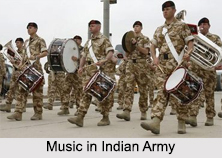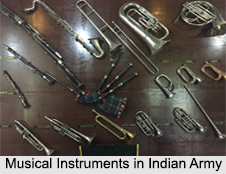 Music in Indian Army was played during a march, as a call to arms, to signal the start of a battle, to mark the defeat of a chief, as well as to convey orders during battle. Music and soldiers have always been associated with each other. These bands are part of ceremonial attestation parades, official functions, officers mess parties, regimental dinner nights, unit celebrations and drill parades.
Music in Indian Army was played during a march, as a call to arms, to signal the start of a battle, to mark the defeat of a chief, as well as to convey orders during battle. Music and soldiers have always been associated with each other. These bands are part of ceremonial attestation parades, official functions, officers mess parties, regimental dinner nights, unit celebrations and drill parades.
From ancient times, music has inspired man to lead troops in battle. Numerous folklores and songs talk of the heroic deeds of legendary soldiers who are remembered for their valour and courage. The sounding of conch shells and beating of drums heralded the might of armies which fought and faded away but left behind their martial music to inspire others to follow their deeds. For centuries, the armies are known to have used musical instruments to communicate orders through the medium of music. They had various instruments for war music, to rouse the spirit of warriors, to invoke the blessings of God and to strike terror in the hearts of enemy.
Historical Evidence of Music in Indian Army
In the epic "Ramayana", Hanuman destroyed Lanka while singing the praise of Lord Rama. In the "Mahabharata", Lord Krishna inspired Arjun to destroy the Kaurava army by explaining the "Gita" through the medium of music. Playing of music before, during and after battle is much in evidence in the Mahabharata. In the Shanti Parva of Mahabharata it is said, "To encourage the multitude in battle let such noises as these be made with horns and drums".
The following words are the most often repeated in the account of the Great Battle.
"There arose a tumultuous uproar caused by the blare of Trumpets, the thundering of drums, the blowing of conch shells besides shouts and cries".
 These words occur on the fall of every hero, on every important occasion and on every significant success.
These words occur on the fall of every hero, on every important occasion and on every significant success.
The Epic advises the use of martial music in order to raise the morale of own troops and to strike terror in the minds of the enemy"s troops. Each warrior carried a "Sankha" (Conch shell) with a distinctive note which heralded his arrival, signalled a challenge to opponents and conveyed the arrival of help for allies. Musical instruments in general used at the time were the "Mridanga", "Bhori", "Panava", "Puskara" and all varieties of drums, tambourines, trumpets, conch shells and cow"s horn. These instruments were collectively referred to as "Vaditrani".
Music Band in Indian Army
Musician in the Indian Army formed a part of the "Patti" (Foot soldiers) or infantry. The passion music evokes cannot be matched by the most eloquent oration. The "Beating Retreat", goes back ancient times, which marked the end of the day"s battle and declared peace till sunrise.
The regiments began maintaining regular bands since the 19th Century and these bands began playing for ceremonial and official functions as well. The Indian military bands have composed and played several stirring marches by talented musicians. "Kadam Kadam Badaye Ja" has been adopted as the army song which is also the favourite amongst them.
The military bands, as they exist today were reorganised by General (Field Marshal) K.M. Cariappa. He is the first Indian commander-in-chief who took keen interest in establishing the Indian Military School of Music at Panchmarhi in 1951. A proper balanced military band consists of a band master and 33 musicians.




















